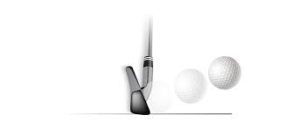 Get the most out of your swing – get fit to the highest smash factor. Smash factor is a simple ratio of ball speed divided by clubhead or swing speed. This is a measure of how efficient you are in transferring energy to the golf ball. As an example, if your ball speed off your driver is 140 mph and your clubheead speed is 100, your smash factor is 1.40. The theoretical limit on a driver is roughly 1.46 but we see numbers of 1.50 to 1.52 consistently using TrackMan II. Fairway woods, hybrids, irons and wedges will all have lower smash factors mostly due to the actual loft of the club. We are, however, seeing some smash factors approaching 1.50 on some of the exotic irons, hybrids and fairway metals. Unfortunately, unless your swing and ball speed are measured on a launch monitor that captures both ACCURATELY, the highest smash factors will not be represented correctly.
Get the most out of your swing – get fit to the highest smash factor. Smash factor is a simple ratio of ball speed divided by clubhead or swing speed. This is a measure of how efficient you are in transferring energy to the golf ball. As an example, if your ball speed off your driver is 140 mph and your clubheead speed is 100, your smash factor is 1.40. The theoretical limit on a driver is roughly 1.46 but we see numbers of 1.50 to 1.52 consistently using TrackMan II. Fairway woods, hybrids, irons and wedges will all have lower smash factors mostly due to the actual loft of the club. We are, however, seeing some smash factors approaching 1.50 on some of the exotic irons, hybrids and fairway metals. Unfortunately, unless your swing and ball speed are measured on a launch monitor that captures both ACCURATELY, the highest smash factors will not be represented correctly.
When you optimize your smash factor you are getting the most distance possible because you are getting the highest possible ball speed for your swing speed. Accuracy can still be an issue and I will address that a little later.
So how do you achieve the optimum smash factor? It relates to several factors:
- Hitting the proverbial “sweet spot” on the clubface.
- Having a shaft that delivers the most energy to the ball.
- Finding a head that is at maximum specs allowable by the USGA
- Playing a ball that fits your ball speed
Finding the sweet spot on the clubface is a matter of having the correct length, weight and flex in the shaft of the club. By design, most clubhead manufacturers are making the sweet spot and forgiveness (MOI or Moment of Inertia) much larger, especially on drivers and fairway metals. On drivers, hitting the ball slightly towards the toe and slightly above centerline usually results in the highest smash factor. In general, heel hits are not good as they not only cause loss of ball speed but increase spin which robs you of distance. Hitting on the heel can be caused by a club that is too long, a shaft that is too light or heavy (depends upon your swing), or a shaft that is too stiff. Conversely, hitting on the toe can be caused by a club that is too short, too heavy, and too flexible. Another loss of smash factor comes from hitting shots thin (low on the face) or fat.
Again, the shaft is the transmission that takes your swing speed and delivers it properly through the clubface to the ball. If the shaft is too heavy or too stiff you can actually lose clubhead speed. But, lighter shafts and more flexible shafts do not always create more speed. That is why a clubfitter will measure your tempo, transition and release points and then have several shaft options available to optimize your performance.
Every manufacturer is talking about “higher ball speeds” these days. The USGA is now using a slightly different measurement for drivers called CT (contact time) that allows for an easier way to measure the “hotness” of a face. This is done for drivers through hybrids. In our testing, we have definitely seen some heads perform to higher smash factors than others, most notably the Ping G LST and EPIC SubZero. In irons, there are a lot of new heads that are exceeding 1.45 smash factors (PXG, Callaway, Mizuno) which creates more distance and usually tighter shot dispersion.
With all of the new technology in golf balls, playing a ball that gives you more “pop” off the face without increasing spin can actually give you a few more yards. Again, you have to weigh the advantage of distance versus feel and performance around the green.
Bottom line? If you want more distance which means shorter shots into the green and using a more forgiving iron, get fit to optimize your smash factor. Oh, and as for accuracy, the last thing we want for our customers it to maximize smash factor while hitting their drives into the next fairway or flying the green. It all has to work together. The right, head, shaft, ball and contact on the face will give you more accuracy AND distance!
Dan Sueltz
